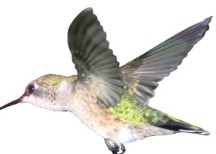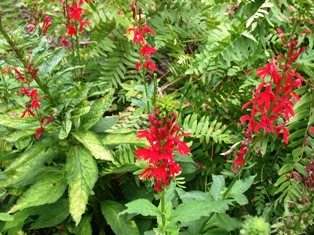Discover Florida Nature
It's time to explore the natural Florida


|
|
|
|
|
 Hummingbirds
live only in the Americas. Of the 338 species known, 16 are found in the
United States and 3 occur in Florida. Black-chinned and rufous
hummingbirds occasionally can be seen in Florida during the winter. The
ruby-throated hummingbird is by far the most common hummer in the state.
This feathered jewel is about 3 inches long and weighs as little as a
penny. Its name describes the most brilliant part of the mature male's
plumage. The throat feathers contain air bubbles that give off an
iridescent red tone in full light. Both sexes, young and mature birds,
have metallic green backs and white-tipped tail feathers. Hummingbirds
live only in the Americas. Of the 338 species known, 16 are found in the
United States and 3 occur in Florida. Black-chinned and rufous
hummingbirds occasionally can be seen in Florida during the winter. The
ruby-throated hummingbird is by far the most common hummer in the state.
This feathered jewel is about 3 inches long and weighs as little as a
penny. Its name describes the most brilliant part of the mature male's
plumage. The throat feathers contain air bubbles that give off an
iridescent red tone in full light. Both sexes, young and mature birds,
have metallic green backs and white-tipped tail feathers. The ruby-throat's breeding range extends from central Kansas to the east coast and from Saskatchewan to central Florida. Although some birds may stay in south Florida year-round, most winter in Mexico and South America. Males arrive in Florida in March. Females arrive about a week later. Nesting in Florida begins in April. The nest is a walnut-size structure of plant down, adorned with lichens, moss, and bound with spider webs or fine plant fibers. Nests frequently are built over water. The female lays 2 eggs less than ½ inch long. After 20 days of incubation and 4 weeks of growing, young hummingbirds leave the nest. One of the most fascinating things about hummingbirds is their helicopter-like flying stunts. Not only can hummers suspend their bodies in midair, they can also fly backward, upward, even upside down. These maneuvers are possible because of an unique design that allows the wing to move very freely and in almost any direction at the shoulder. Soaring is the only maneuver they can not perform. Contrary to popular belief, hummingbirds do not hum. The sound is made by their rapid wing movements (50-200 beats per second). To acquire enough strength to support all of this high-speed activity, hummingbirds need to consume large amounts of high-energy food. Adult hummingbirds feed primarily on nectar. Nectar is an energy-rich food that is used rapidly. One hummingbird may need nectar from hundreds of blossoms every day to maintain its body weight. Long needlelike bills and specially adapted tongues allow them to reach nectar in deep tubular flowers. The last half-inch of the long tongue is divided into equal halves, each grooved on the outside edge to form two tube-like structures. Nectar is drawn into the tongue much the same way liquid travels up a straw. Hummingbirds can lick at a rate of 13 times per second, and their stomach is capable of holding about 0.18 ounces of nectar at one time. They also feed to a lesser extent on insects. For their size, hummingbirds have among the largest appetites in the bird world. They feed every 10 or 15 minutes from dawn until dusk. During this period, they eat more than half their weight in food and 8 times their weight in water. Hummingbirds have developed 2 adaptations to help them survive the hours of darkness when they cannot feed. First, they eat as much as they can just before dark. During the night, their heart rate and body temperature drop to conserve energy. If they did not go into this sort of daily hibernation stage, they likely would starve.  Cardinal
Flower (Lobelia cardinalis)- Cardinal flower grows native along
streambeds all over the Southern United States and is a real treasure in
the garden by providing one of the truest reds available. It thrives in
areas where other perennials would rot and adds bold color to shady
corners of the garden. Cardinal flowers also boast a long bloom time,
which is a huge bonus as the plant also attracts hummingbirds. The
delicate looking, but boldly colored flowers create a strong presence
near water features or planted in masses. A perennial which features
erect, terminal spikes of large, cardinal red flowers on unbranched,
alternate-leafed stalks, the cardinal flower rises typically to a height
of 2-3 feet. Tubular flowers are 2-lipped, with the three lobes of the
lower lip appearing more prominent than the two lobes of the upper lip.
Finely-toothed, lance-shaped, dark green leaves are up to 4" long.
Flowers are very attractive to butterflies and hummingbirds, but not
cardinals. White and rose colored forms are also known. Cardinal
Flower (Lobelia cardinalis)- Cardinal flower grows native along
streambeds all over the Southern United States and is a real treasure in
the garden by providing one of the truest reds available. It thrives in
areas where other perennials would rot and adds bold color to shady
corners of the garden. Cardinal flowers also boast a long bloom time,
which is a huge bonus as the plant also attracts hummingbirds. The
delicate looking, but boldly colored flowers create a strong presence
near water features or planted in masses. A perennial which features
erect, terminal spikes of large, cardinal red flowers on unbranched,
alternate-leafed stalks, the cardinal flower rises typically to a height
of 2-3 feet. Tubular flowers are 2-lipped, with the three lobes of the
lower lip appearing more prominent than the two lobes of the upper lip.
Finely-toothed, lance-shaped, dark green leaves are up to 4" long.
Flowers are very attractive to butterflies and hummingbirds, but not
cardinals. White and rose colored forms are also known.
|
|
|
Advertise | Privacy Statement | Dog Encyclopedia | Video |Contact | Alaska Nature |
|